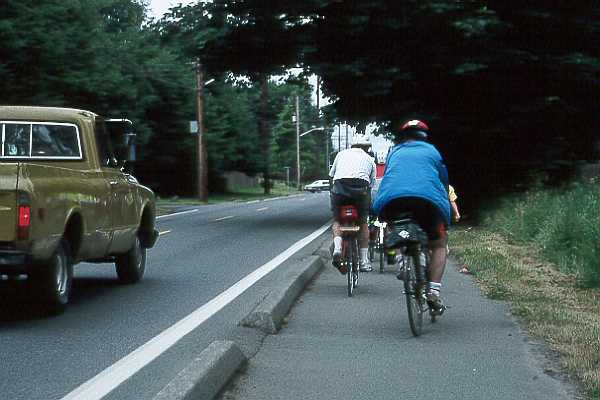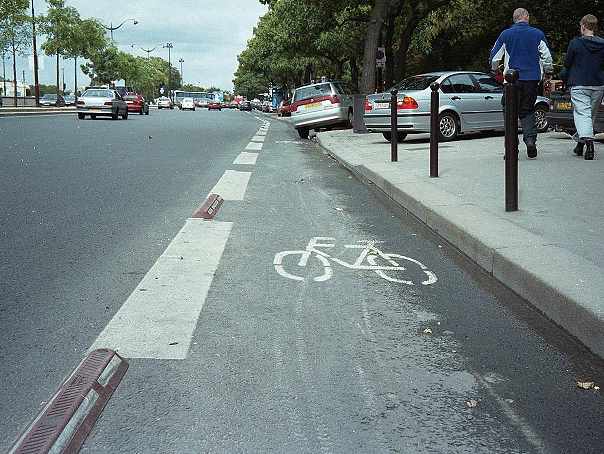JOHN S. ALLEN'S BICYCLE FACILITIES, LAWS AND PROGRAMS PAGES |
||
 |
 |
|
JOHN S. ALLEN'S BICYCLE FACILITIES, LAWS AND PROGRAMS PAGES |
||
 |
 |
|
Killer Bike Lanes with Raised BarriersOne of the most hazardous types of fall for a bicyclist is the diversion-type fall, in which the bicycle's front wheel is steered to one side, making it impossible to balance. Diversion-type falls typically are caused by a step in the riding surface in the same or nearly same direction the bicyclist is traveling. Common examples are
Off-road riders face additional hazards, for example tree roots. Diversion-type falls can also occur when bicyclists are riding in a group and one bicyclist's front wheel overlaps another's rear wheel. In a diversion-type fall, the front wheel can no longer steer, and the bicycle is suddenly swept out from under the bicyclist, who has no time to break the fall by putting down a hand or foot. The bicyclist's forward momentum is partially converted into rotation, resulting in a heavy landing on the hip, shoulder and/or head. It is all the more remarkable, then, that bike lanes have been constructed with raised barriers which promise a diversion-type fall to any bicyclist who strays into them. And more: the bicyclist will be toppled into the path of overtaking motor traffic. These lanes violate the AASHTO guidelines for bicycle facilities design, which apply in the USA, yet they still continue to be built. The bicyclists in the photo below are participants in a group ride organized by a leader of the Cascade Bicycle Club to examine the bicycle facilities in and around Olympia, Washington, USA during the 1991 League of American Bicyclists National Rally. The Cascade Bicycle Club was suing local authorities over the failure of this bike lane to meet recognized design guidelines. The driver of the pickup track is keeping a safe distance from the bike lane, and clearly has more sense about its hazards than the engineer who designed it. Upon reading an earlier version of this Web page, Judy Murphy, who also attended the conference, responded by e-mail:
|
Two-way barrier-separated bike lane, Olympia, Washington, USA, 1991
 John S. Allen photo |
| In the USA, political pressure for barrier treatments often occurs in areas which are
changing from rural to suburban, and where the residents demand a sidewalk on what had
been a rural road. As the traffic volume increases, bicyclists delay motorists more often.
Also, residents want a place where they think it will be safe for their children to ride,
and so the idea of having the same pavement do double duty as a sidewalk and bicycle lane
arises. In the photo above, an existing road shoulder was separated off into the bike lane by installing the barriers. Studies of bicycle accidents, for example the Pasanen study posted on this Web site) and the Wachtel/Lewiston study published in the September, 1994 ITE Journal, have conclusively proven sidewalk-type bikeways more hazardous than riding in the street. The hazard produced by the barriers is in addition to all the other usual problems with a sidepath or sidewalk bikeway. The barrier increases the danger not only for bicyclists who ride in the bike lane, but for those who refuse to ride in it. An appropriate improvement for bicyclists on a road like the one in the photo would be to widen both sides of the roadway to allow comfortable bicyclist/motorist lane sharing. The added pavement width need be no greater than for the two-way lane in the photo. The shoulders, or mowed grass strips outside the shoulders, might also be used by pedestrians. Notice that there is a mowed grass strip in the photo above: a good treatment here need not have cost any more than the bad one did; however, a separate sidewalk would be desirable if pedestrian traffic is heavy. The photo below was taken in Paris, France. The bike lane is one-way; still, the logic of the Paris engineers is formidable. The rubber barriers ("bordurettes" or colloquially, "boudins" [sausages]) are high enough to cause an uncomfortable jolt to a motorist, or to topple a bicyclist in front of an overtaking car. Car-overtaking-bicycle collisions, the only kind the lane separation might prevent, are approximately 1 percent of all serious bicycle crashes in urban areas, but it stands to reason that the barriers cause such collisions, as well as other types of crashes. |
Barrier bike lane near the Eiffel Tower, Paris, France, summer 2000.
 Alan Forkosh |
Contents © 2001, John S. Allen |